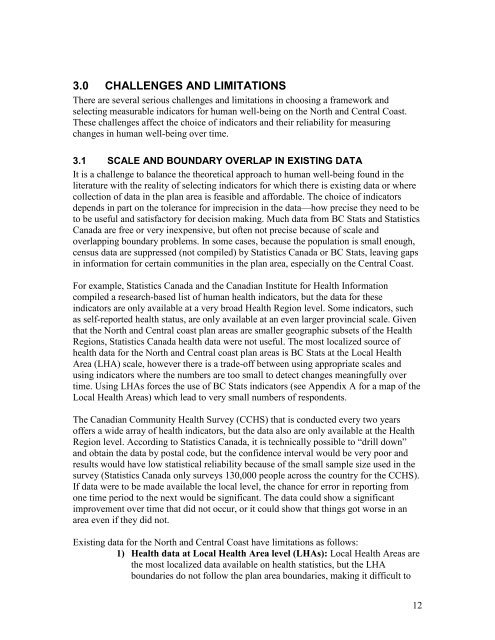Final report - Integrated Land Management Bureau
Final report - Integrated Land Management Bureau
Final report - Integrated Land Management Bureau
Create successful ePaper yourself
Turn your PDF publications into a flip-book with our unique Google optimized e-Paper software.
3.0 CHALLENGES AND LIMITATIONS<br />
There are several serious challenges and limitations in choosing a framework and<br />
selecting measurable indicators for human well-being on the North and Central Coast.<br />
These challenges affect the choice of indicators and their reliability for measuring<br />
changes in human well-being over time.<br />
3.1 SCALE AND BOUNDARY OVERLAP IN EXISTING DATA<br />
It is a challenge to balance the theoretical approach to human well-being found in the<br />
literature with the reality of selecting indicators for which there is existing data or where<br />
collection of data in the plan area is feasible and affordable. The choice of indicators<br />
depends in part on the tolerance for imprecision in the data—how precise they need to be<br />
to be useful and satisfactory for decision making. Much data from BC Stats and Statistics<br />
Canada are free or very inexpensive, but often not precise because of scale and<br />
overlapping boundary problems. In some cases, because the population is small enough,<br />
census data are suppressed (not compiled) by Statistics Canada or BC Stats, leaving gaps<br />
in information for certain communities in the plan area, especially on the Central Coast.<br />
For example, Statistics Canada and the Canadian Institute for Health Information<br />
compiled a research-based list of human health indicators, but the data for these<br />
indicators are only available at a very broad Health Region level. Some indicators, such<br />
as self-<strong>report</strong>ed health status, are only available at an even larger provincial scale. Given<br />
that the North and Central coast plan areas are smaller geographic subsets of the Health<br />
Regions, Statistics Canada health data were not useful. The most localized source of<br />
health data for the North and Central coast plan areas is BC Stats at the Local Health<br />
Area (LHA) scale, however there is a trade-off between using appropriate scales and<br />
using indicators where the numbers are too small to detect changes meaningfully over<br />
time. Using LHAs forces the use of BC Stats indicators (see Appendix A for a map of the<br />
Local Health Areas) which lead to very small numbers of respondents.<br />
The Canadian Community Health Survey (CCHS) that is conducted every two years<br />
offers a wide array of health indicators, but the data also are only available at the Health<br />
Region level. According to Statistics Canada, it is technically possible to “drill down”<br />
and obtain the data by postal code, but the confidence interval would be very poor and<br />
results would have low statistical reliability because of the small sample size used in the<br />
survey (Statistics Canada only surveys 130,000 people across the country for the CCHS).<br />
If data were to be made available the local level, the chance for error in <strong>report</strong>ing from<br />
one time period to the next would be significant. The data could show a significant<br />
improvement over time that did not occur, or it could show that things got worse in an<br />
area even if they did not.<br />
Existing data for the North and Central Coast have limitations as follows:<br />
1) Health data at Local Health Area level (LHAs): Local Health Areas are<br />
the most localized data available on health statistics, but the LHA<br />
boundaries do not follow the plan area boundaries, making it difficult to<br />
12
















